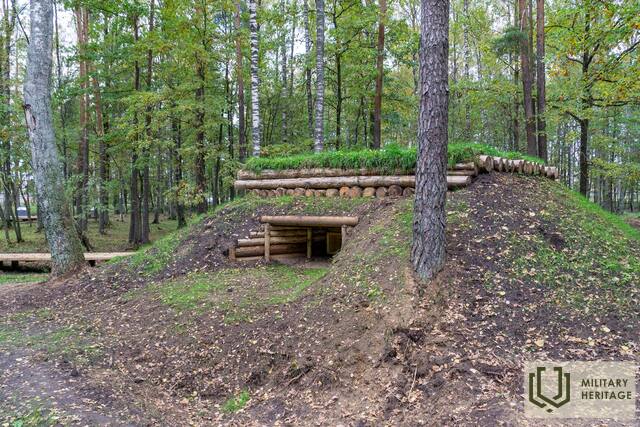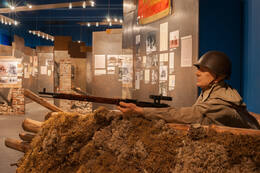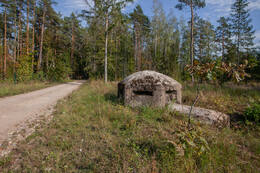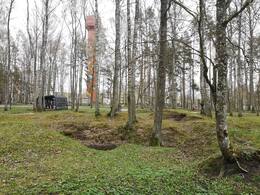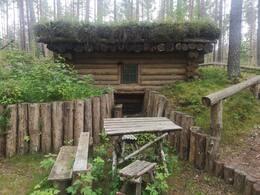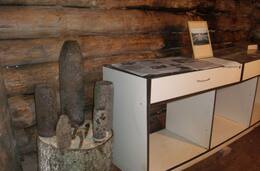Blindage
I World War I, I Wars of Independence, II World War II, IV Soviet Occupation
Also bunker, from French blindage. A fortification structure of wood and earth for soldiers to live in, which provides protection against artillery fire.
The construction of a dugout usually resembles a log cabin completely buried in the ground. These structures were built mainly to provide headquarters, field hospitals and rest areas for personnel.
One important factor is the invisibility of the structure. This allows for the highest possible personnel security.
Depending on the availability of materials, earth, wood, reinforced concrete, stone and metal structures can be used for the construction of earth shelters.
Related objects
Latvian War Museum
The Latvian War Museum is located in the Old Town not far from the Freedom Monument in a historic defence building called the ‘Powder Tower’. There are 11 exhibits in the museum. There are various weapons, documents, uniforms, awards, badges and other items detailing the everyday life of a soldier in war. The Latvian War Museum is one of the oldest museums in Latvia. Its origins can be found in World War I. Museum’s collection was made up mainly of personal items of soldiers or items found on battlefields. After Latvia gained its independence the main goal of the museum became to create an exposition on the military history of Latvia and the active role of the population in protecting their land. In 1937 the museum was expanded and was technically one of the most modern museums in Europe at that time. The Powder Tower was one of the fortification towers of Riga. Some evidence dates back to 1330 where it has been mentioned as the ‘Sand Tower’. The tower was destroyed in 1621 when Riga was besieged by the Swedish Army. But in 1650 a new tower for storing gunpowder and weapons was built. After the city’s fortifications were taken down, the Powder Tower remains as one of the most important pieces of evidence of the Riga defence system.
Concrete bunker firing point near Gauja willage
Located in Inčukalns municipality, on the side of the road near the village of Gauja, near the junction of the A2 and A3 highways.
The fortification is a very rare and valuable example of fortification. The structure was designed for one person to observe an important traffic junction. To the NW is a bridge over the Gauja, to the E - a crossing over the Inčupīte, to the SW - a road junction and to the S - one of the main traffic routes - the Vidzeme highway. The reinforced concrete fortification was part of the surrounding trenches, the exact time of construction of which is unknown. Most likely, it was built by the German army during World War II. The site requires further research to clarify the information.
At the end of the 19th century, the area around Inčukalns Manor developed into an important traffic hub. During World War I, the area gained the importance of a defensive area, where possible hostilities were planned. Fortifications were built near traffic routes, the Inčukalns railway station and the Gauja River crossing. The area retained its strategic importance in subsequent wars.
Today, you can view the fortification, which is freely accessible.
Latvian riflemen positions and trenches in Tīreļi
Latvian Riflemen dugouts and trenches in Tīreļi are located in Babīte parish, Mārupe municipality, in the vicinity of the Antiņi Latvian Riflemen Cemetery and the former medicine warehouse. During World War I this was the defensive position of Latvian Riflemen of the Russian Imperial Army. A complex of trenches and surface dugouts was built in the sandy hills. Trench or positional warfare is the best way to accurately describe World War I and emphasise the importance of fortifications. They were based on the research of military engineers and adapted to the environment and the development of new weapons. The everyday life of a soldier is a continuous improvement of defensive fortifications. Sometimes soldiers would give the dugouts names that reminded them of their homes and would help to forget about the reality of the war. Trench lines were complex defensive systems that were hard for the enemy to take. With the development of weapons these defences became even more sophisticated. The roofs of dugouts were reinforced to withstand artillery shells. Trenches were made in changing patterns and directions so that explosions would cause as little damage as possible. Movement passages had pockets that were used as short-term hiding spots during artillery fire, because they protected soldiers from shrapnel and rubble. Today part of the fortification has been restored and you can visit 3 restored dugouts and a 100 m long section of the trenches.
Private Collection “Family Barn”
The private collection “Family Barn” is located at the family estate “Ābeļu Putniņi”. Created in 2007, it reveals the history of one family through stories, objects and a reconstructed trench shelter.
Visitors are offered an insight into the history of World War I, the Latvian Army, World War II, the Brothers’ Cemetery in Riga and the Christmas Battles. The old barn displays embroidered table cloths, homemade folk costumes, a cupboard with tableware, skis and a chariot wheel donated by Baron Korf. In 2011, the equipping of the restored birch wood trench shelter was commenced. In it, a furnace, a sleeping area, and stands displaying objects related to the First World War – broken tableware, photographs and rusted weapon parts are on display there. The exhibition allows visitors to experience the scenes of the First World War as described in the Blizzard of Souls, a novel by Aleksandrs Grīns. Special attention is paid to the Vidzeme 4th Riflemen Regiment and the Christmas Battles. The following soldiers are mentioned: Robert Soks, who is buried at the Broth ers’ Cemetery in Riga, as well as writers Aleksandrs Grīns, Jānis Akurāters, composer Arvīds Žilinskis and others.
The exhibition grounds feature bomb pits from World War I and a spring from which the soldiers drew drinking water. A tour of the site lasts for 1.5–2 hours and is available in Latvian and Russian.




